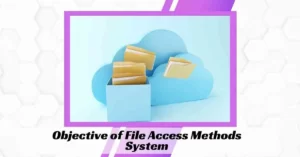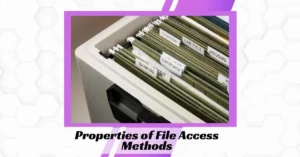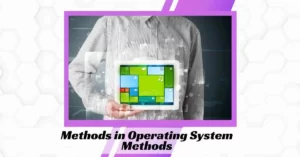Table of Contents
ToggleWhat is a File System?
A file system is a collection of related data that is stored on secondary or non-volatile media such as magnetic discs, optical discs, and tapes. It is a data-gathering method that is utilized as a medium for providing input to and receiving output from that program.
A file, in general, is a sequence of bits, bytes, or records whose meaning is defined by the creator and user of the file. Every file has a logical location where it is stored and retrieved.
The objective of File Access Methods System

The following are the primary goals of the file access methods system:
- It supports I/O for a wide range of storage device types.
- Reduces the likelihood of data loss or destruction.
- Assists the operating system with standardizing I/O interface functions for user programmes.
- It supports many users’ I/O in a multiuser system context.
Read: What are Allocation Methods in OS (Operating System)
Properties of File Access Methods

These are some significant file access methods properties:
- Files are saved to disc or other storage and do not vanish when a user signs off.
- Files contain names and access permissions that allow for regulated sharing.
- Files could be sorted or more complicated structures could be created to indicate their relationship.
Write the File Access Permissions?
File permissions govern which users can do what with a file. file access methods, File permissions are an important component of a resistance strategy. Only a portion of the system is shared in public systems. At the very least, system files must be safeguarded from unauthorized alteration by intruders.
Methods in Operating System

As a file is used, information is read and accessed into computer memory, and there are numerous methods for accessing the file’s information. file access methods, Some systems limit file access to just one mechanism. Some systems, such as IBM’s, provide a variety of access mechanisms, and determining which one is best for a given application is a significant design challenge.
A file can be accessed into a computer system in three ways:
a. Sequential access
b. Direct access
c. Index sequential
Sequential Access
That is the most basic mode of access. Data science, The data in the file is processed sequentially, file access methods, one record after the other. This is by far the most common way of access; for example, editors and compilers typically access the file in this manner.
The majority of file operations are read and write. file access methods, A read operation -read next- reads the file’s next place and advances a file pointer, which keeps track of I/O location. Similarly, for the -write next- command, add to the end of the file and move forward to the newly written data.
Key points:
a. In an order, data is accessed one record after another.
b. When we use the read command, it advances the cursor by one.
c. When we use the write command, memory is allocated and the pointer is moved to the end of the file.
d. For tape, such a strategy makes sense.
Advantages of Sequential Access Method
- This file access technique is straightforward to implement.
- It uses lexicographic order to efficiently go to the next entry.
Disadvantages of Sequential Access Method
a. This sort of file access method is delayed if the next file record to be retrieved is not present adjacent to the current record.
b. To insert a new record, you may need to move a significant portion of the file.
Direct Access
The direct access approach, often known as the relative access method, is another option. A fixed-length logical record that allows the software to quickly read and write the record. in no particular order. file access methods, Because disc permits random access to any file block, direct access is based on the disc model of a file.
The file is seen as a numbered sequence of blocks or records for immediate access. So, we may read block 14, then block 59, and finally block 17. file access methods, A direct access file has no restrictions on the order of reading and writing.
A block number given to the operating system by the user is often a relative block number, with the first relative block of the file being 0 and then 1 and so on.
Key Points
- In file access methods in os, this method is faster than the sequential access method.
- Allows for ad hoc access. As a result there is no need to go through all of the blocks.
- It is simple to put into action.
Advantages of Direct Access Method
a. The files can be accessible immediately, reducing the average access time.
b. In the direct access approach, there is no need to traverse all the blocks before it to reach a block.
Disadvantages of Direct:
- Due to its complexity, the direct access technique is often difficult to implement.
- Because individuals may access/modify sensitive information, organizations may suffer security risks as a result of direct access. As a result, new security procedures must be implemented.
- Direct access methods in file access methods in operating systems require a long time.
Index Sequential Method
The alternate file access mechanism is constructed on top of the sequential access approach. These methods create the file’s index. Similar to a book’s index, the index contains a pointer to the various blocks. file access methods, We begin by searching the index for a record in the file and then access the file directly using a pointer.
Key points:
- It is constructed on top of Sequential access.
- It controls the pointer by using an index.
Advantages of Indexed Sequential Access:
- If the index table is properly organized, it allows for speedy access to the records.
- Soon, records can be inserted at any point in the file.
Disadvantages of Indexed Sequential Access:
- It is more expensive and inefficient than other file access methods.
- It desires more storage capacity.
Click here to learn: coding
Conclusion
- Certain files may be required by the operating system to be loaded into computer memory.
- In os, there are three file access methods: sequential access, direct access, and indexed sequential access.
- Access to file records in sequential sequence, one after the other, is possible with sequential access.
- The direct access method in file access methods in operating systems provides for random access to file blocks.
- Indexed sequential access differs from sequential access. It inclu
des an index with pointers to different additional file blocks.
Frequently Asked Questions
What is a file access method?
These columns will be given unique names and data types. File access is the procedure that governs how files are accessed and read into memory. In general, operating systems always provide a single access mechanism. There are certain operating systems that offer numerous access methods.
What are the different ways to access a file?
There are three methods for gaining access to a file in a computer system: Index Sequential Method, Sequential-Access Method, Direct Access Method. That is the most basic mode of access. The data in the file is processed sequentially, one record after the other. This is by far the most common way of access; for example, editors and compilers typically access the file in this manner.
How are files read and accessed?
As a file is used, information is read and accessed into computer memory, and there are numerous methods for accessing the file’s information. Some systems limit file access to just one mechanism. Some systems, such as IBM’s, provide a variety of access mechanisms, and determining which one is best for a given application is a significant design challenge.
What are the different types of access methods?
Some systems, such as IBM’s, provide a variety of access mechanisms, and determining which one is best for a given application is a significant design challenge. There are three methods for gaining access to a file in a computer system: Index Sequential Method, Sequential-Access Method, Direct Access Method. That is the most basic mode of access.













